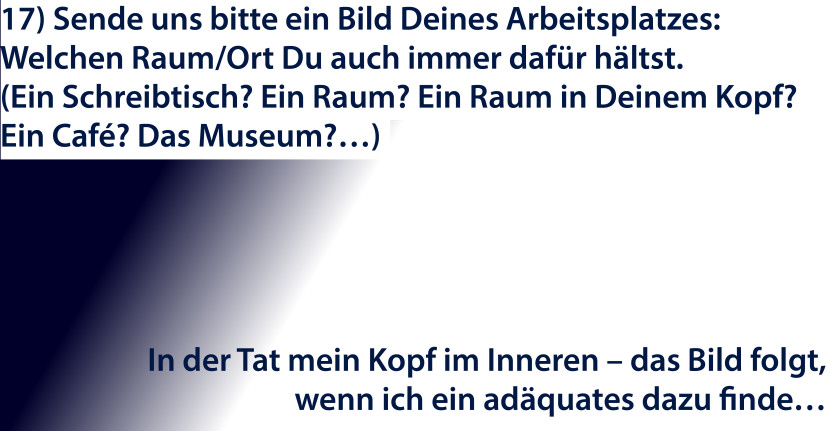In which context are you working as an art educator?
Wiebke Trunk: I work within the confines of a university and as a freelancer. The starting point is my perspective as an artist.
Who are you working with?
WT: With colleagues, employees of cultural institutions, e.g. Institute for Foreign Relations, the Goethe Institute, municipal museums, schools etc.
What is your understanding of art education?
WT: For me this is both an opportunity and a possibility to “use” art. Or to be more precise: to encourage and incite people to combine perception and resistance. I think this manner of dealing with art education is a fundamentally political task.
What is the relationship (for you) between education and art?
WT: See the previous answer.
Why educate people about (contemporary) art?
WT: Because especially here there appear aspects of contemporary problems that could be seen differently and therefore it is possible to establish a critical distance in the “here and now.”
In what kind of relationship do you see the practice of curating and educating?
WT: A reform is long-overdue here. Seen against the background of establishing this distance, the hierarchical practice, that is nonetheless still taking place (especially at events like the documenta, the Venice Biennale etc.), is for me absurd and paradoxical.
Why is art education important for a museum or an institution?
WT: Because this is the only way that the crucial invitation can reach to a wide audience.
Where do we find the (institutional) spaces, in which we can have a discussion about our experiences of art?
WT: In some university spaces, in a few (German-speaking) museums, in private spaces, hopefully in several ateliers – unfortunately rarely in academic circles.
To what extent can art education and art mediation open up a new sphere of action?
WT: It can break open the still strongly regulated hegemonies and create approaches to which the audience, therefore all those who have the opportunity to visit an exhibition, has a basic right. This type of education is the basis of political education through the critical examination of cultural products and artifacts – this includes works of art (as a part of specified instruments for differentiation encoded in Western cultural practices).
When do you think art education is successful? When do you think art education is complicated?
WT: When the mediators are no longer needed and the pleasure in examining, discussing, thinking and (hopefully even once in a while) touching the works of art becomes more and more natural.
Is there a specific method or strategy you currently work with?
WT: I try to win the confidence and trust of my discussion partners and fight for free admission to exhibitions.
What are you currently working on?
WT: On my dissertation (working title: “Regulated Approaches to Art in National Socialism in the so-called Art Reports) and free admission …
Which books and projects are important for your work and why?
WT: Silke Wenk, Hildegard Brenner, W.F. Haug etc. – because they dealt critically with National Socialist art policy as “social engeneering” (Brenner). Here are some book titles:
_Brenner, Hildegard: Die Kunstpolitik des Nationalsozialismus.Hamburg 1963.
_Haug, Wolfgang F.: Die Faschisierung des bürgerlichen Subjekts. Hamburg,Berlin 1987.
_Schmitz-Berning, Cornelia: Vokabular des Nationalsozialismus. Berlin, New York 2000.
_Wenk, Silke: Aufgerichtete weibliche Körper. Zur allegorischen Skulptur im deutschen Faschismus. In: Inszenierung der Macht. Ästhetische Faszination im Faschismus. Ausstellungskatalog. Berlin 1987.
Which questions would you like to ask an art educator?
WT: How can educators network better and how can the difficulties for everyone that arise from competition be overcome intelligently? How can we transform the reflection on our own work – especially the reflexion on forms of specific and exclusionary discourse – into an openness towards different mentalities and (simple) languages
How do you imagine the future of art education?
WT: Responsible, courageous and open.
Wiebke Trunk,
since October 2014: Scientific Collaborator at the Carl-von-Ossietzky University Oldenburg, at the Institute for Art and Visual Culture: Art – Mediation – Education. September 2010 – May 2011: Stipend within the Research Program „Kultur und Außenpolitik“ (Culture and International Politics) for the study: „Voneinander lernen – Kunstvermittlung im Kontext kultureller Diversität“ (Learning from one another – Art Education in the Context of Cultural Diversity). Since 2008 Lecturer and representative at the Institute for Foreign Cultural Relations (ifa) in Stuttgart. Since 2003: Freelance work as art historian, art educator, curator, artist, lecturer, project leader, author. Since 2006: Dissertation project: “The communication of art in Germany in the Nazi era and its development before 1933 and after 1945” at the University of Oldenburg. 1989–1996 Universities of Würzburg and Stuttgart: philosophy and art history; M.A. degree (master’s thesis: “Altarpiece and video image-a comparison in terms of media aesthetics”). 1980–1986 Stuttgart State Academy of Art and Design: stage set and costume design. wiebketrunk.de
Image 1: Response to question 17): Wiebke Trunk. Visualization: Gila Kolb, 2015.
Image 2: Wiebke Trunk, photo: Nanna Lüth.
Published on January 28th, 2016.
Translation: Natascha Raue, Christopher Forlini
Interview: Gila Kolb
